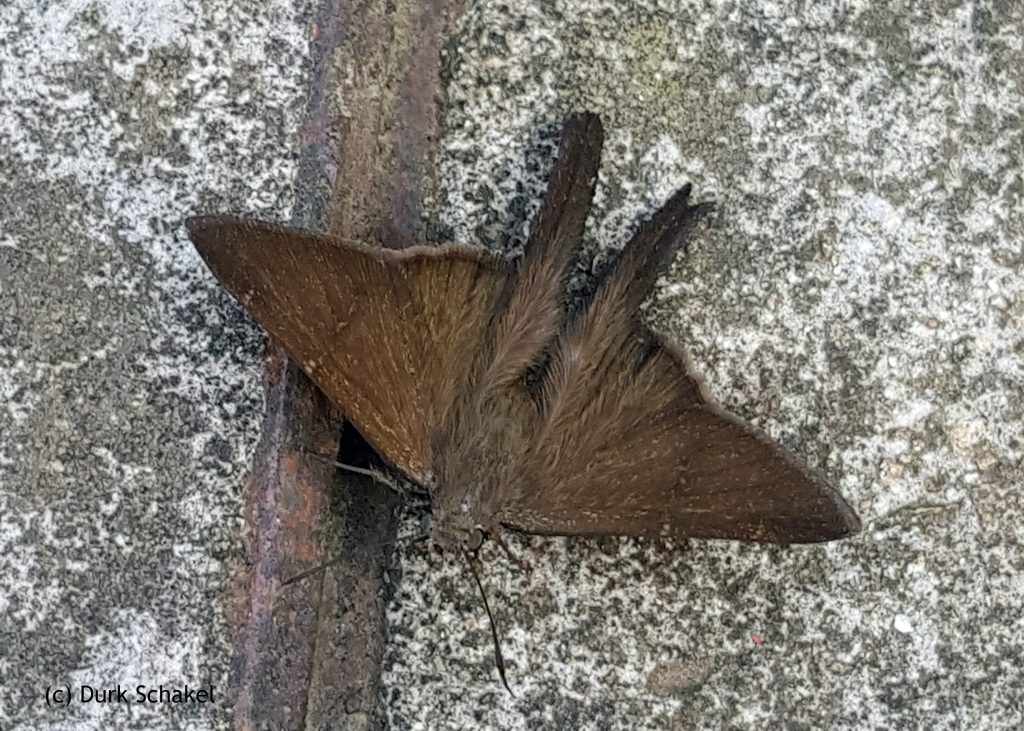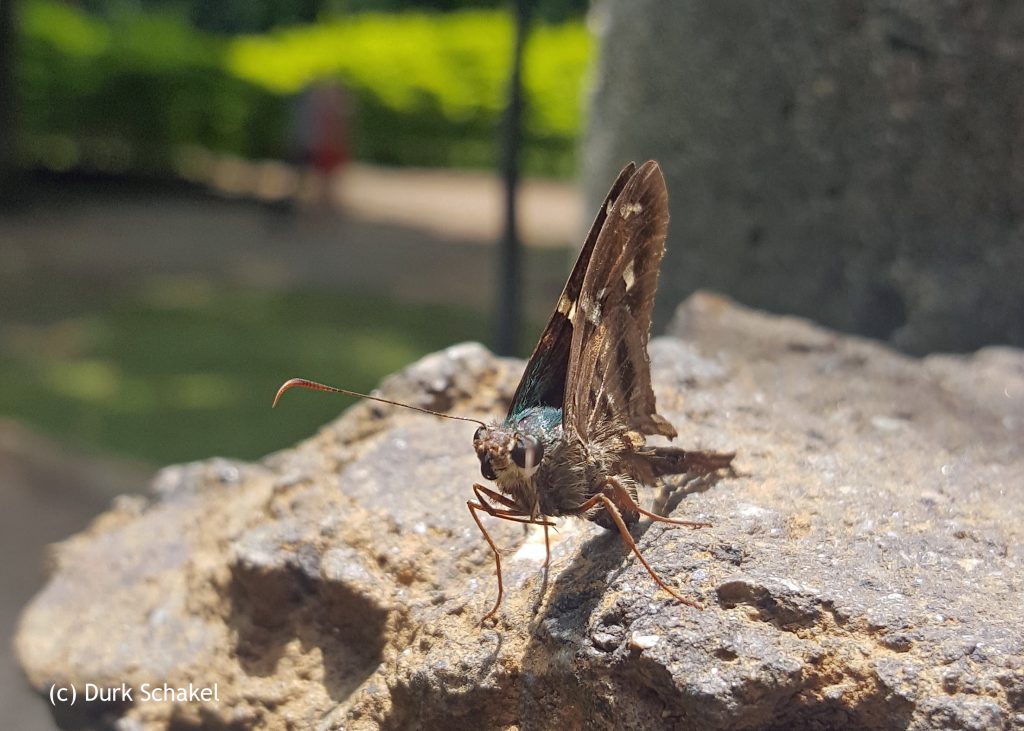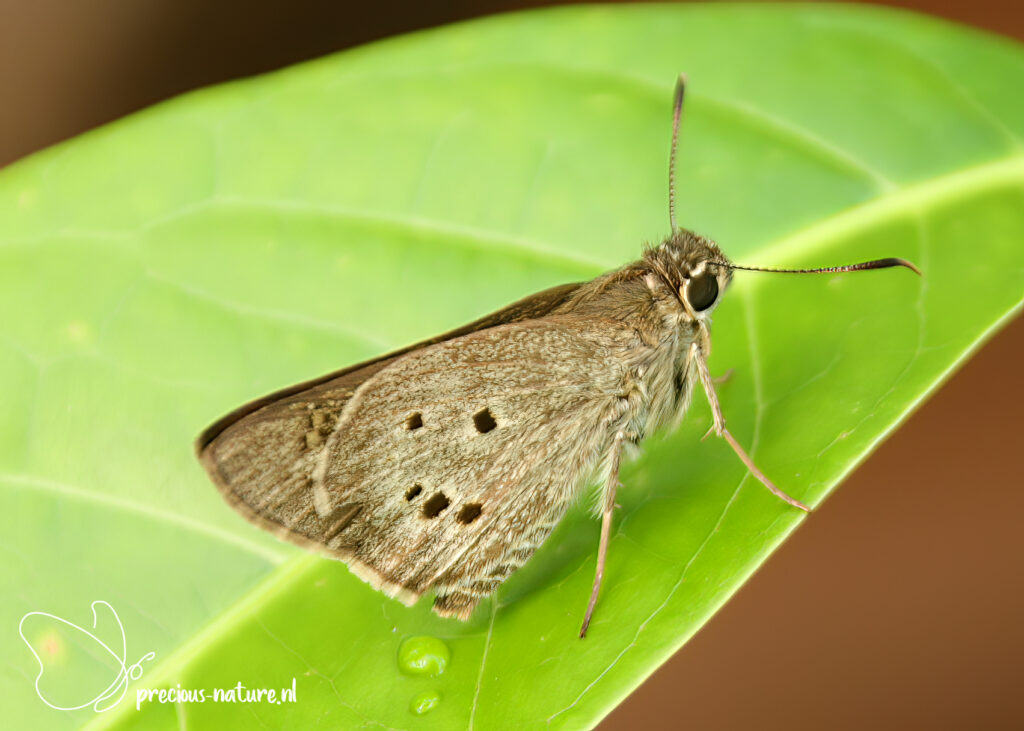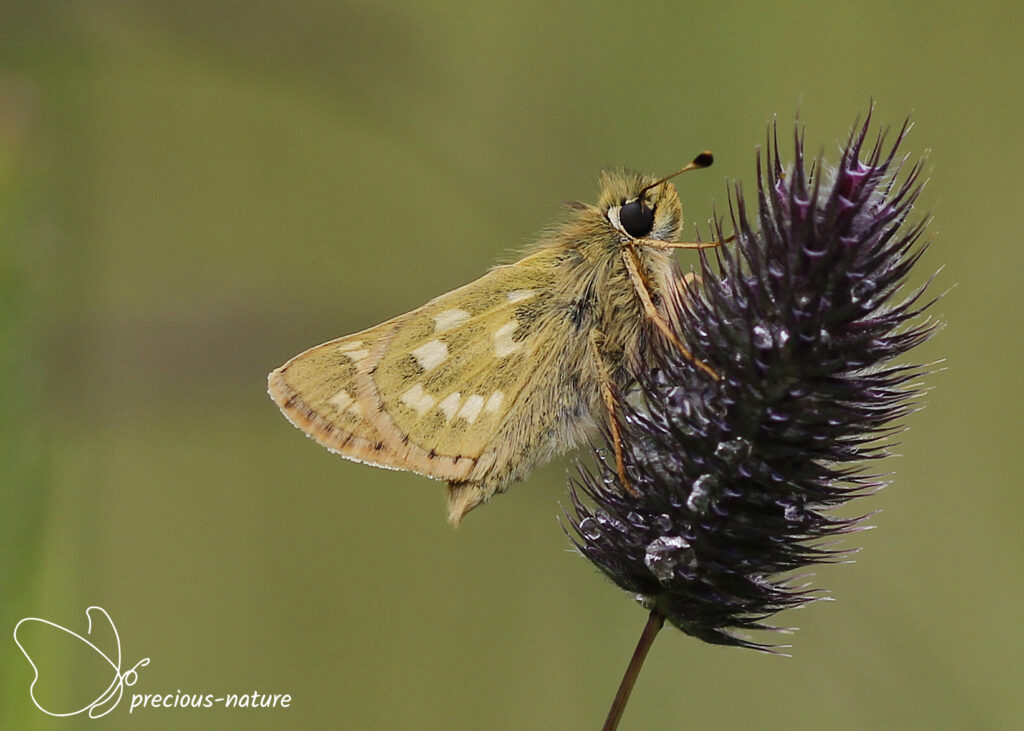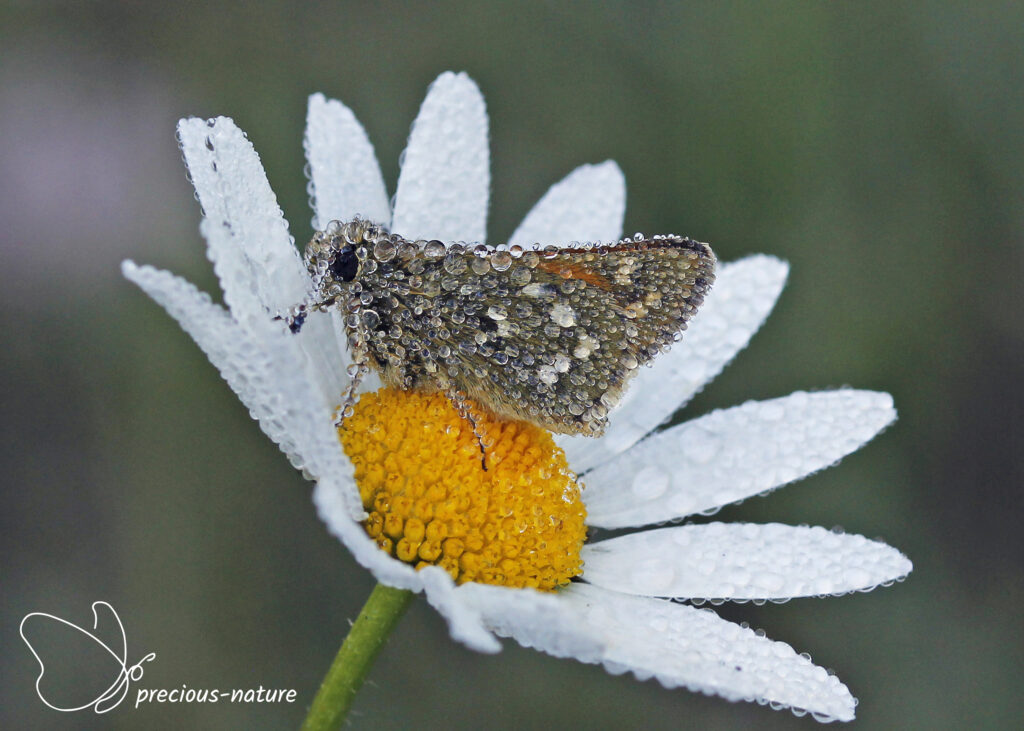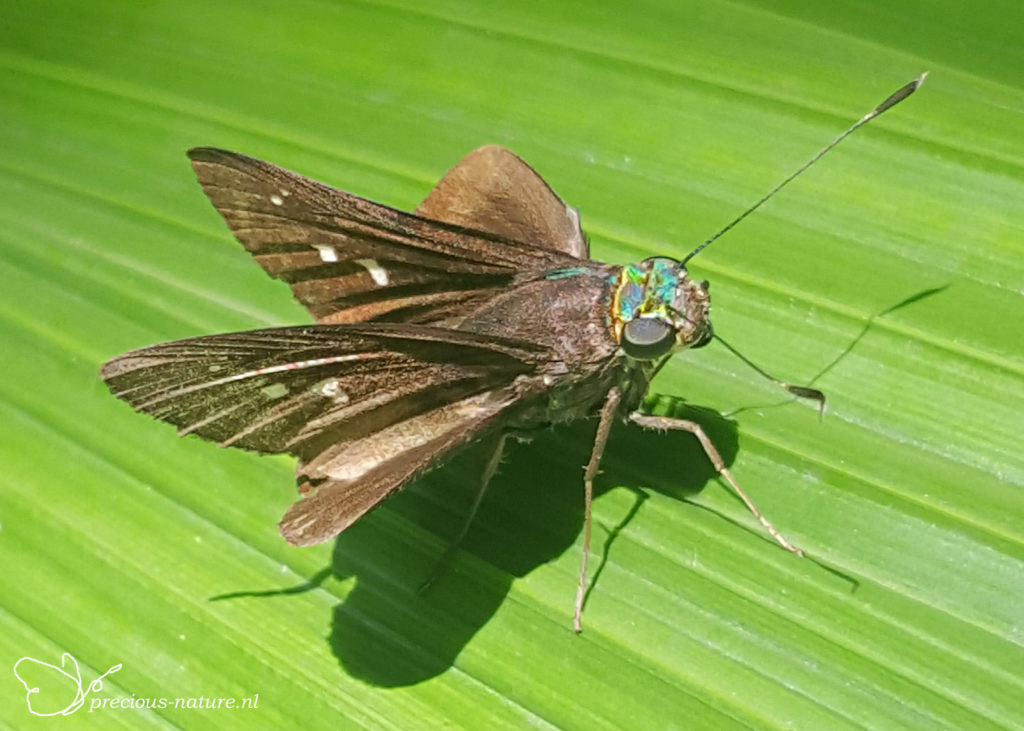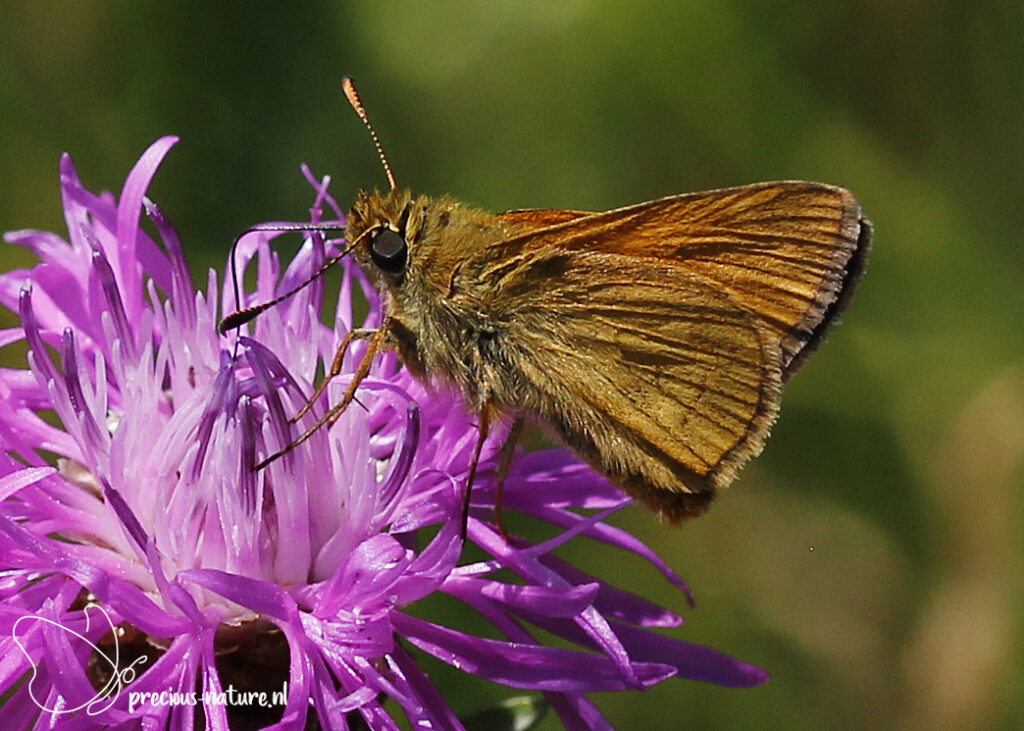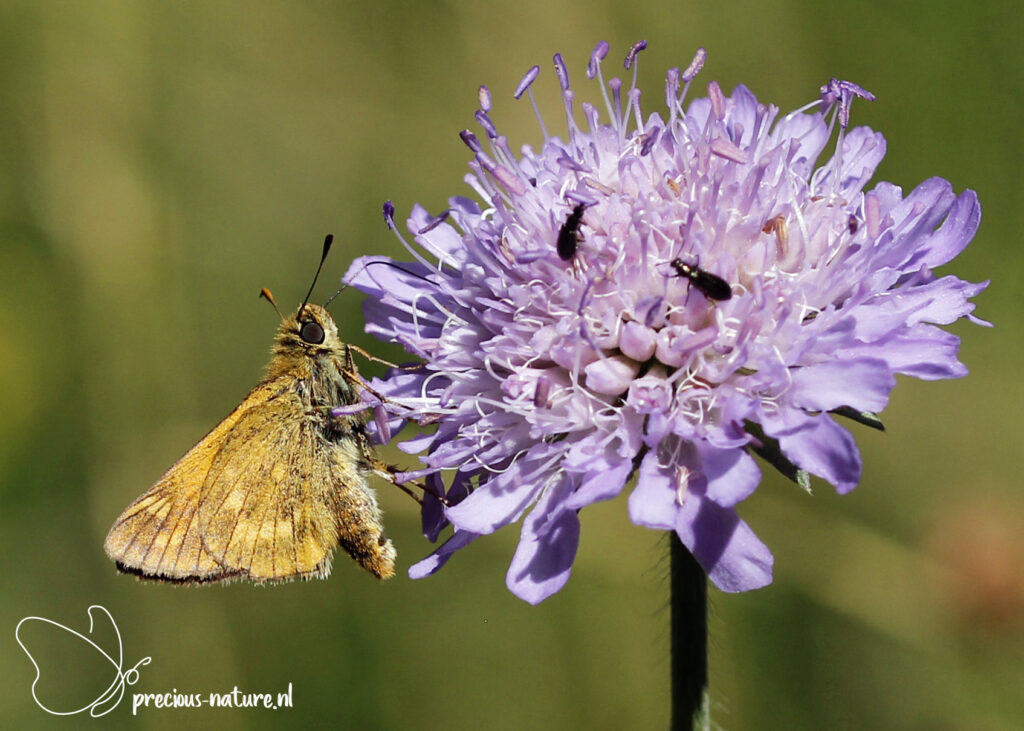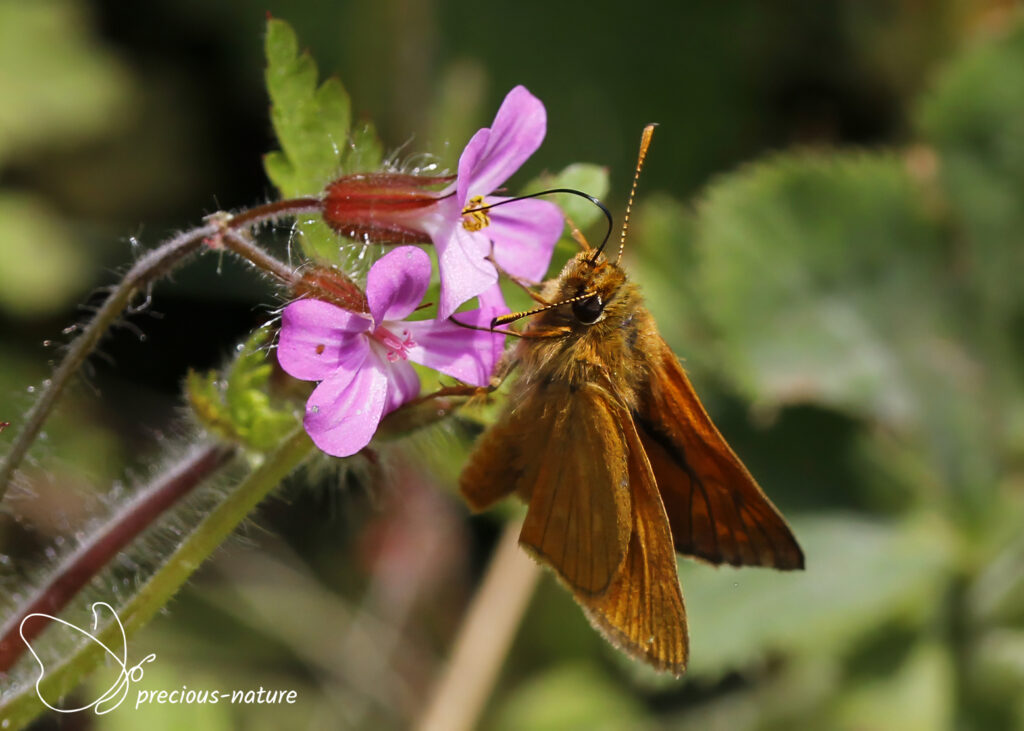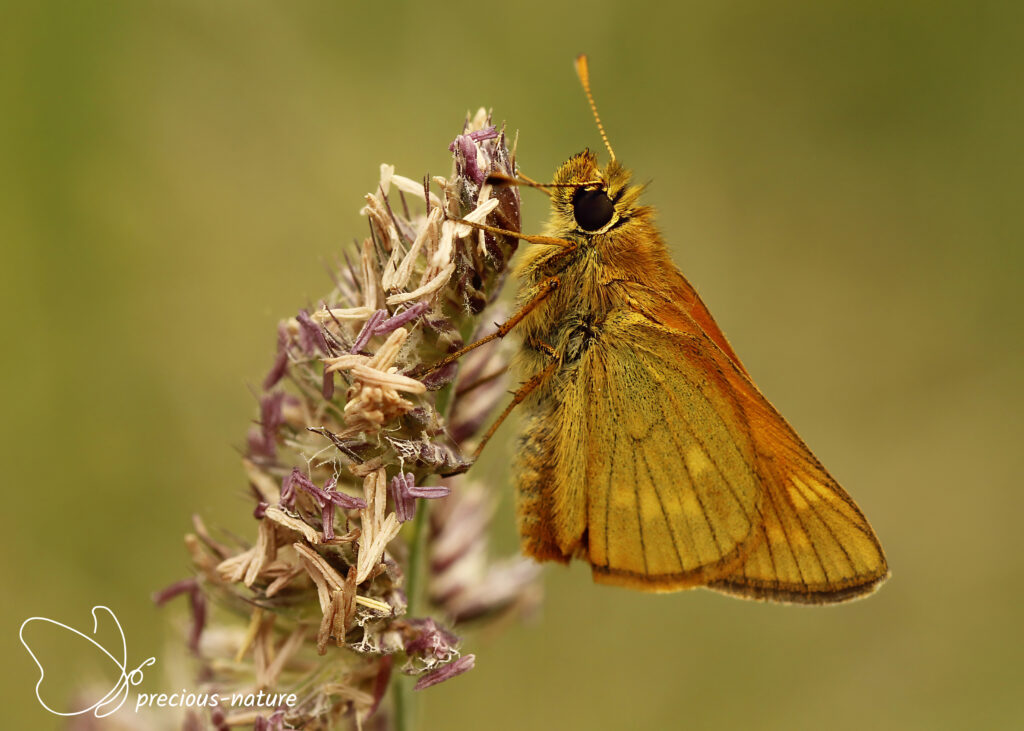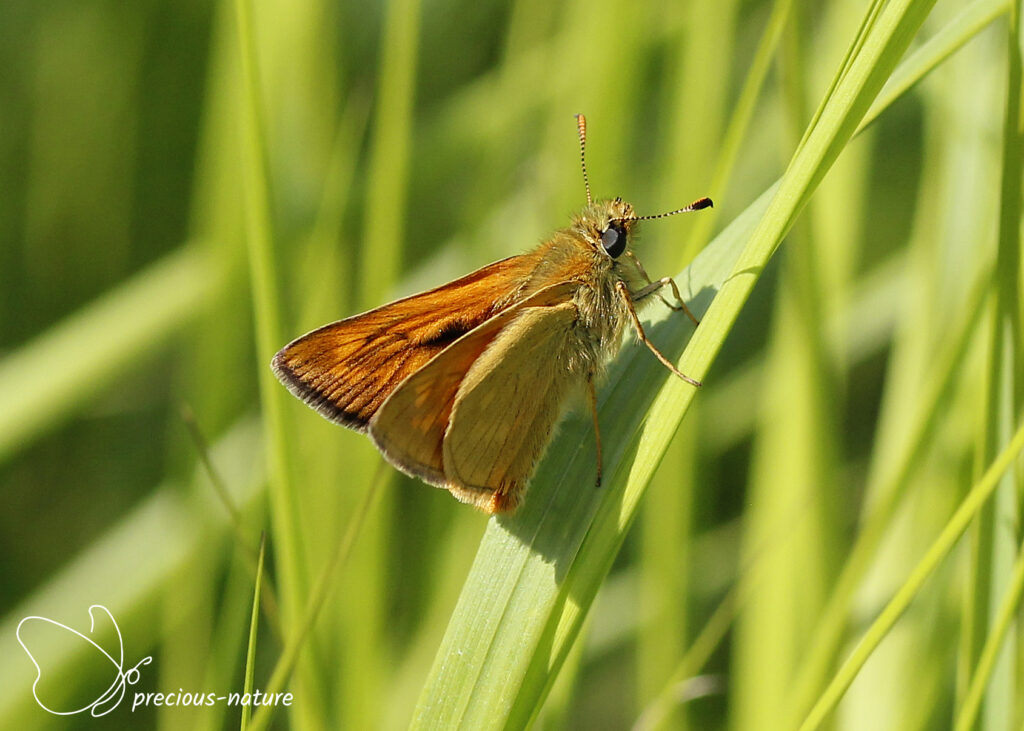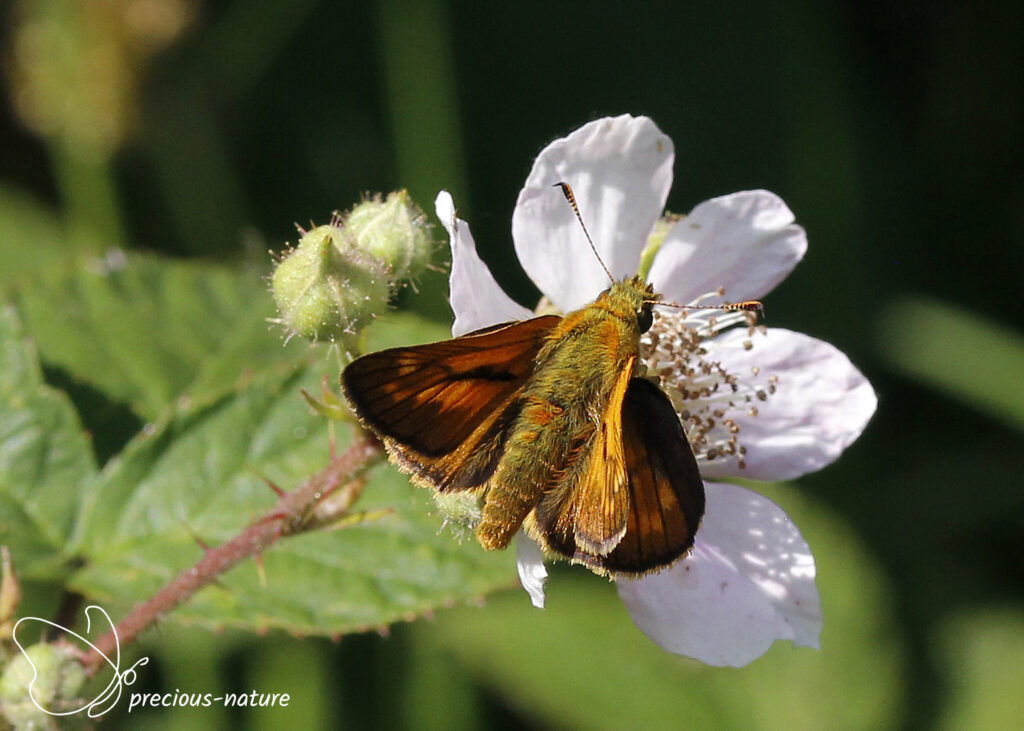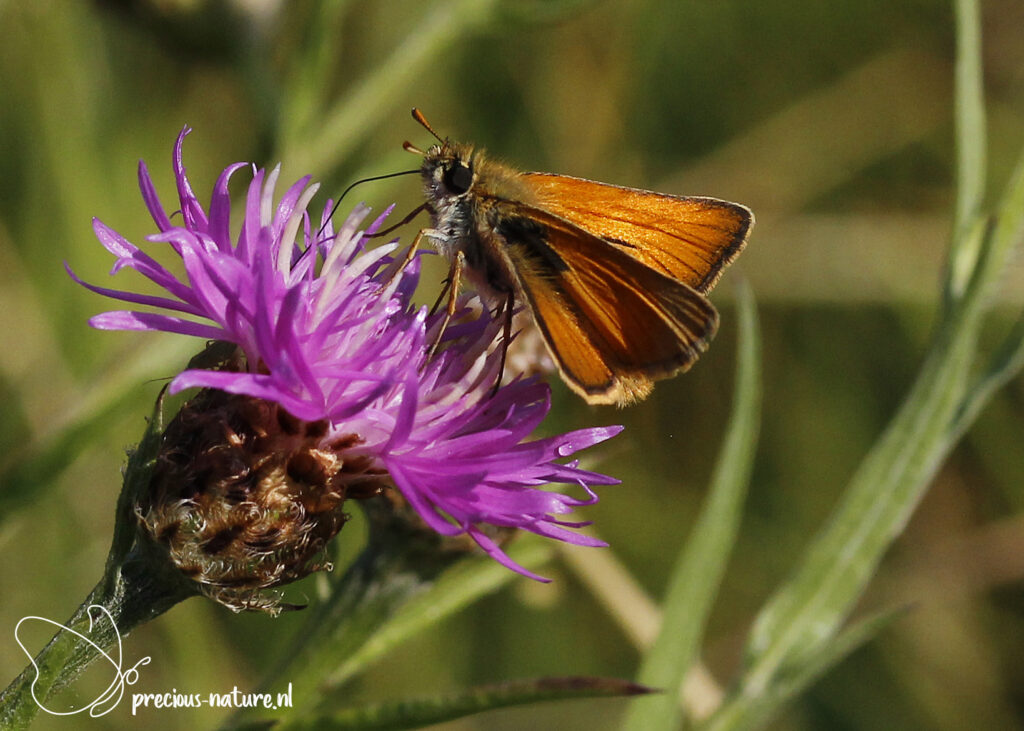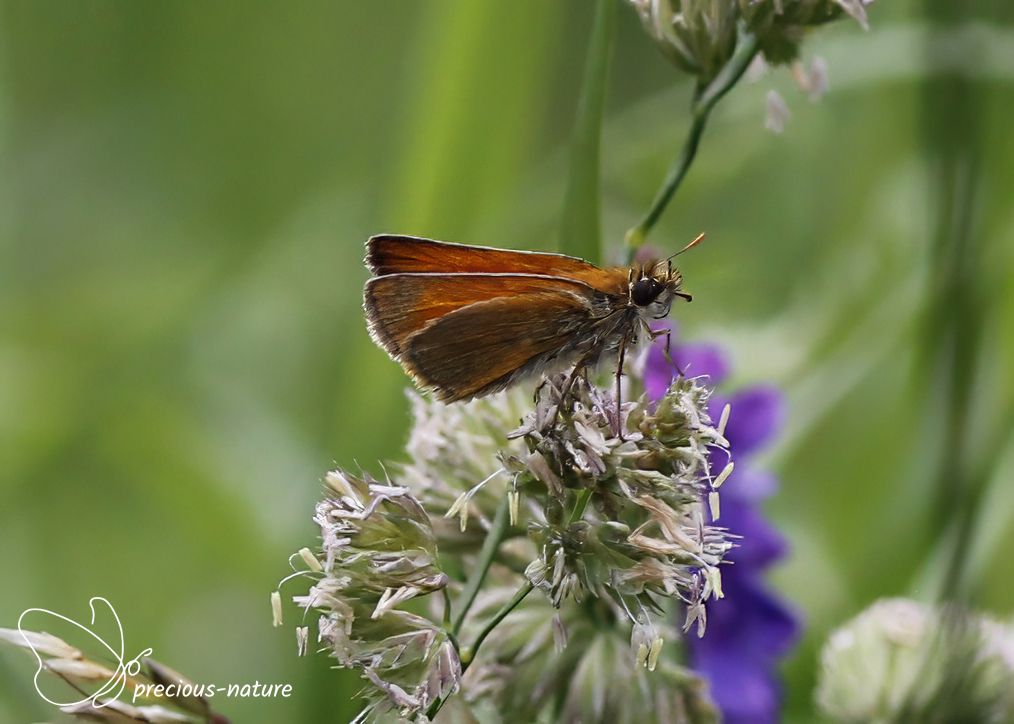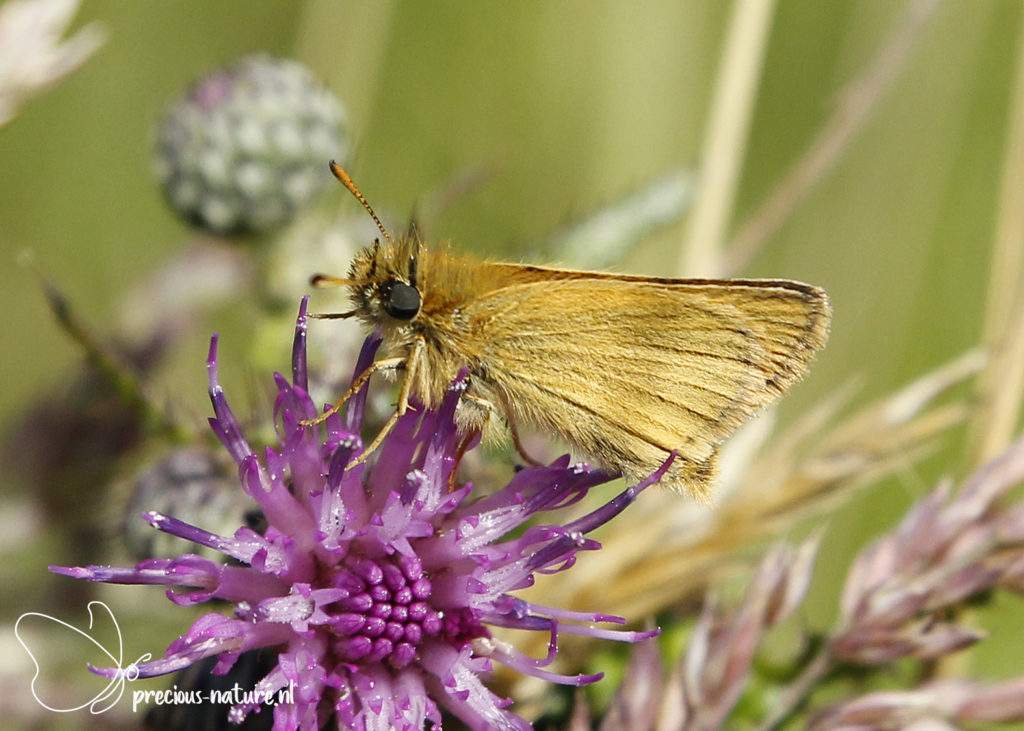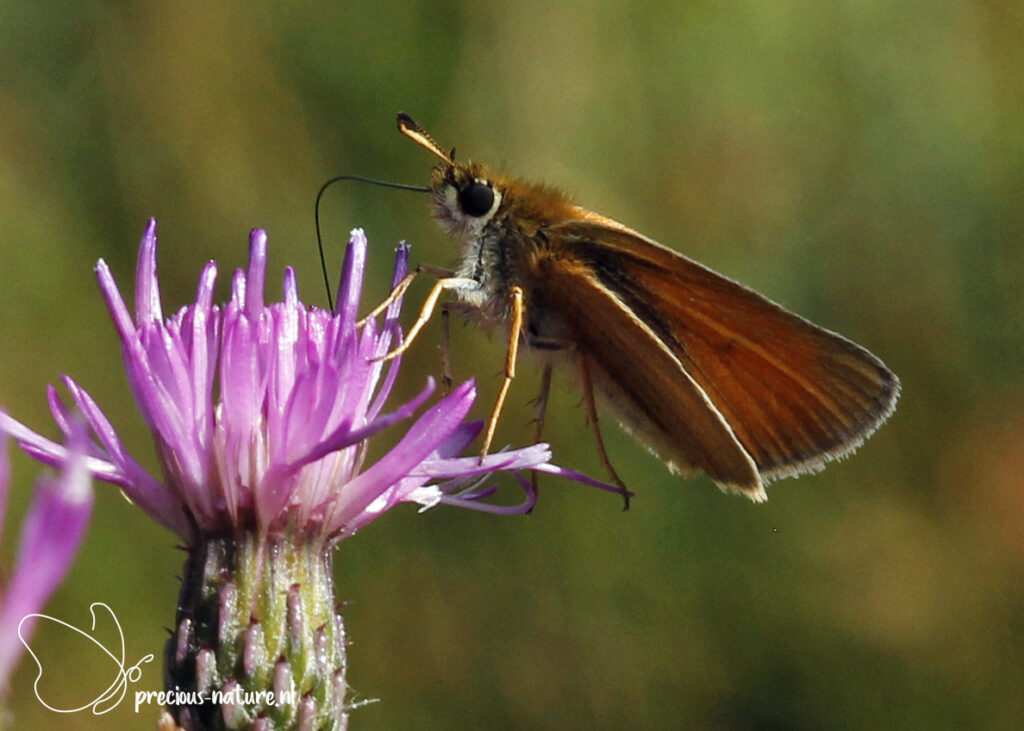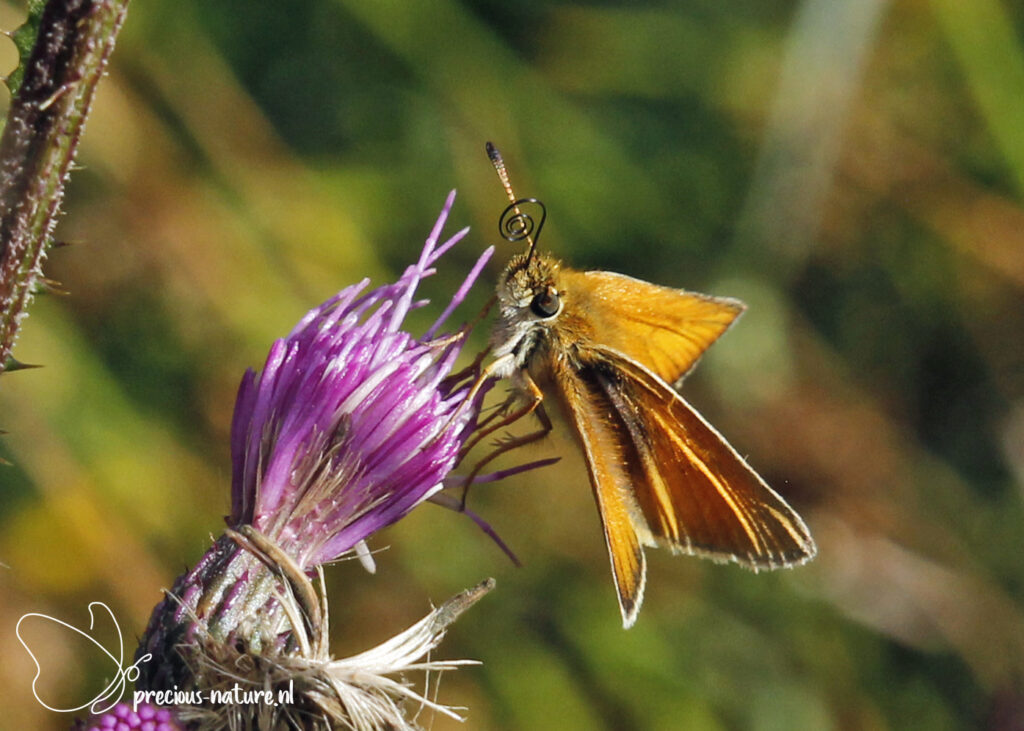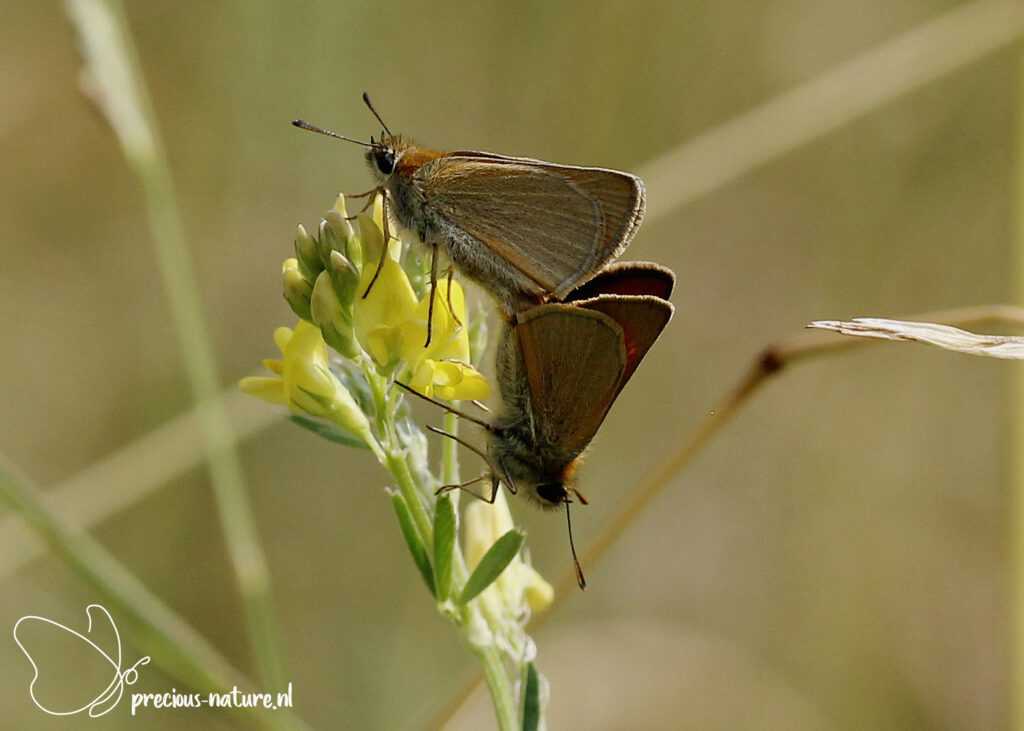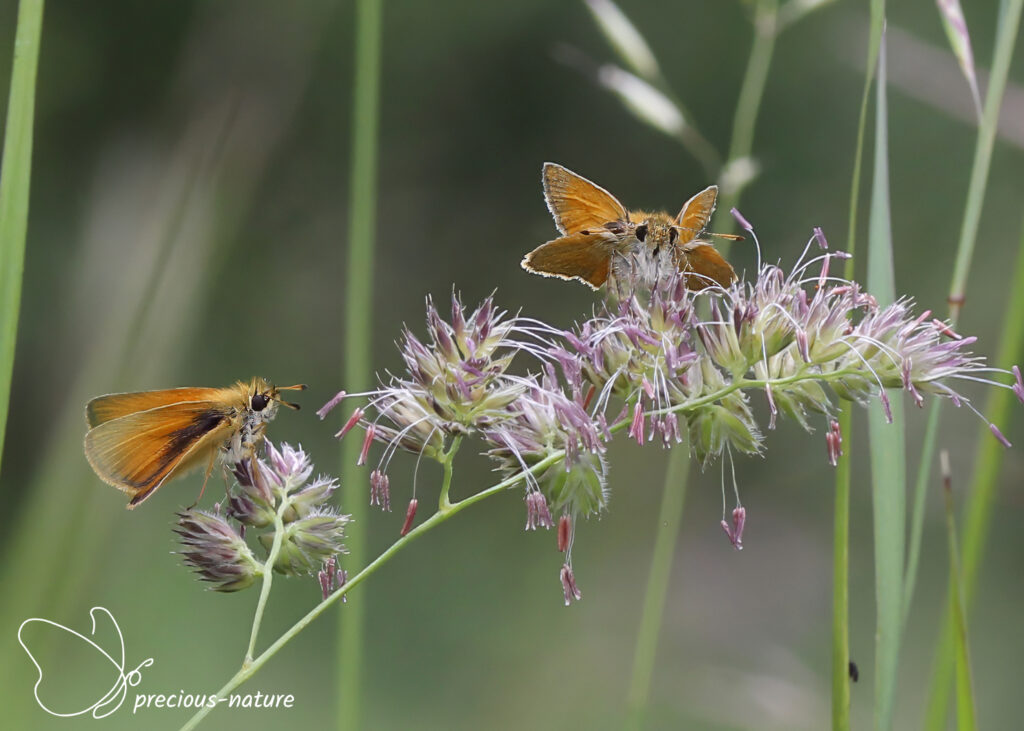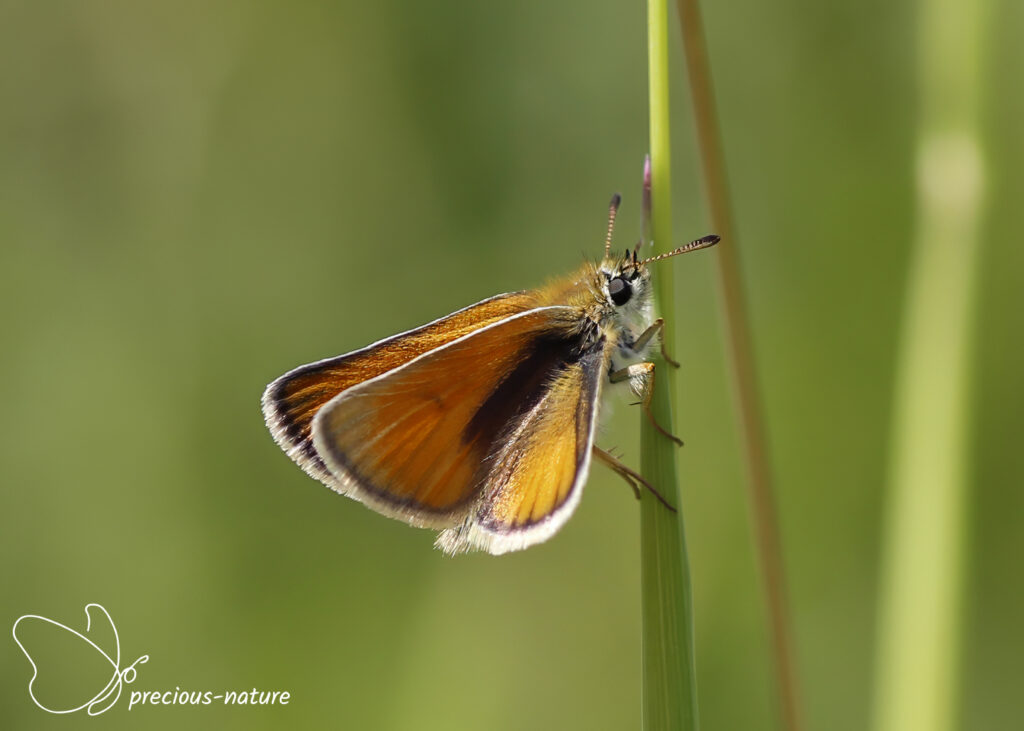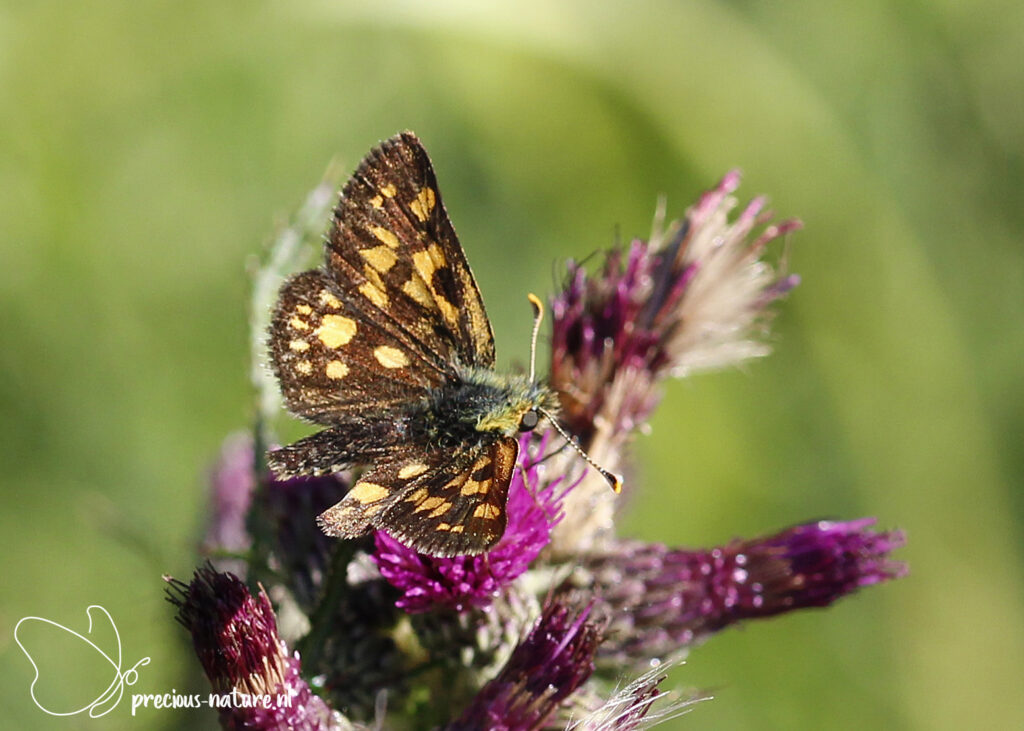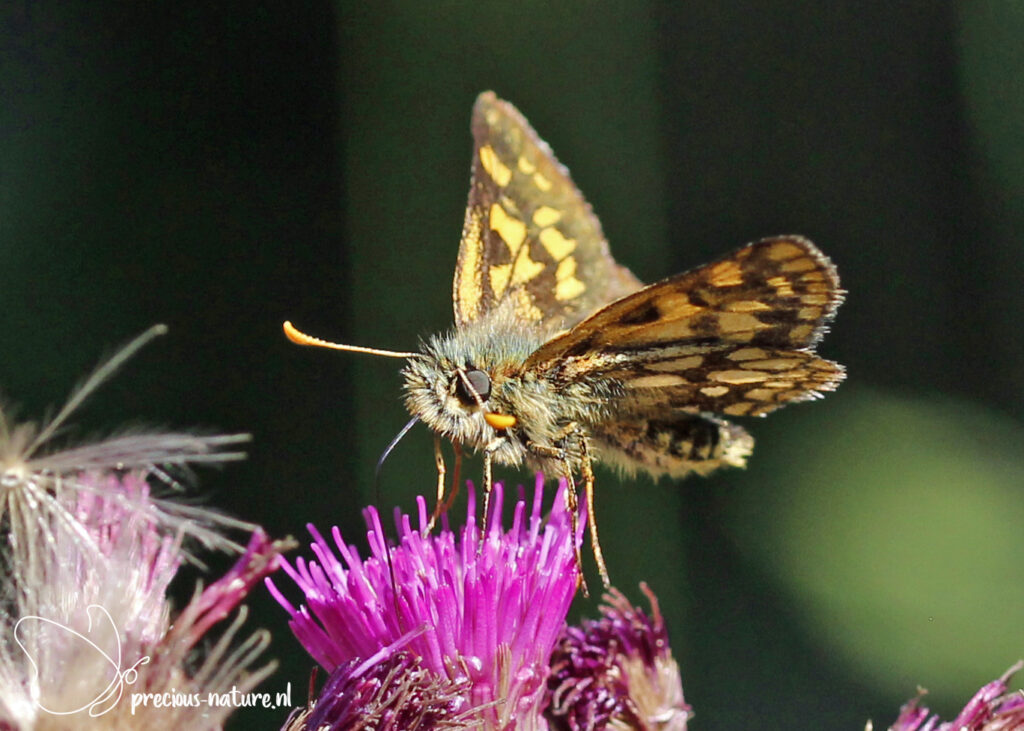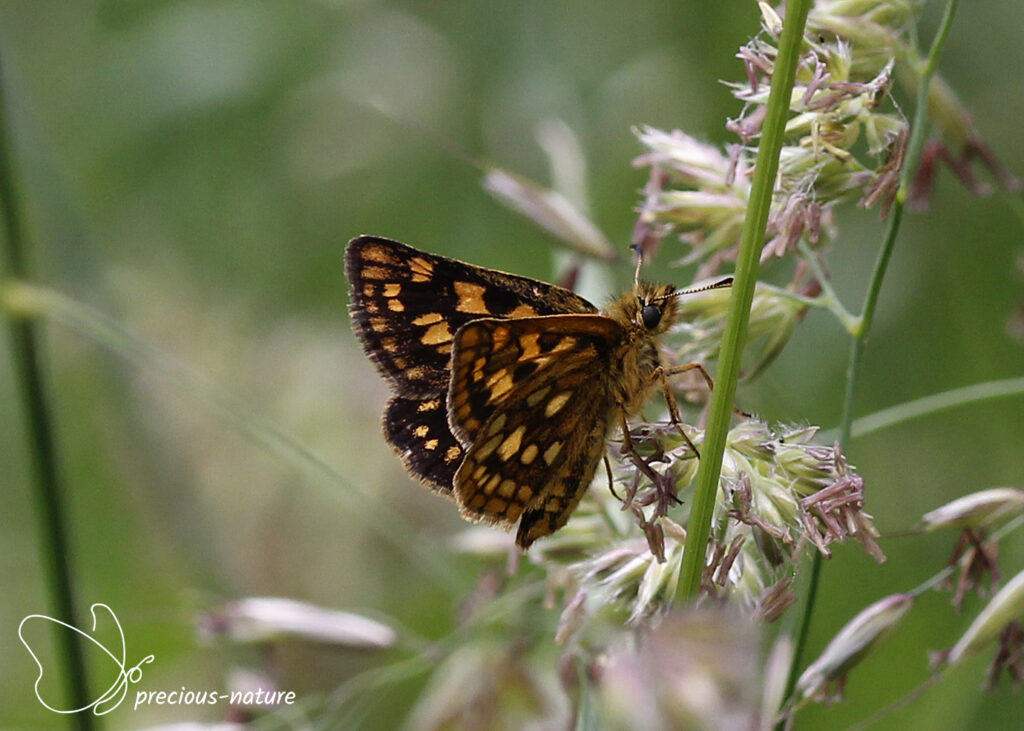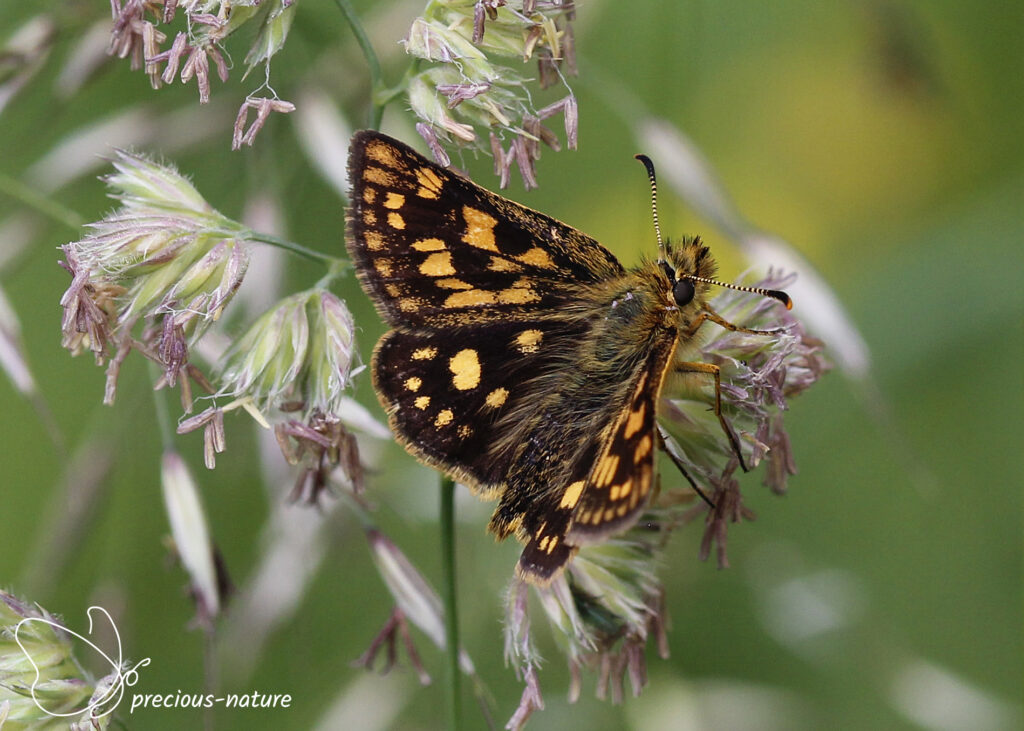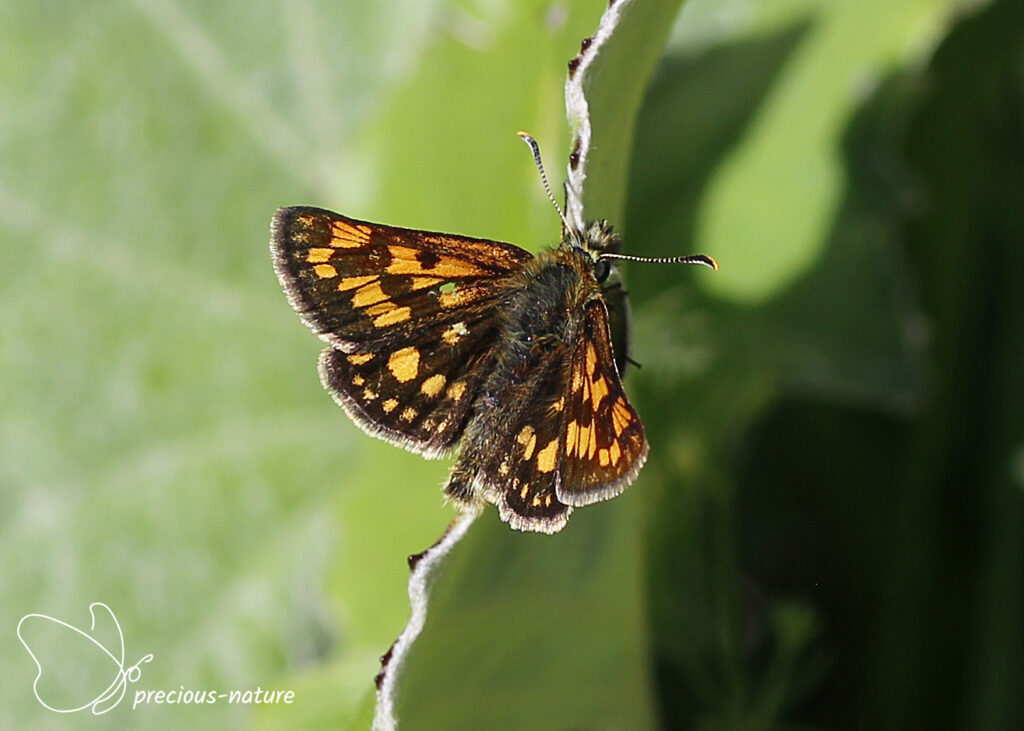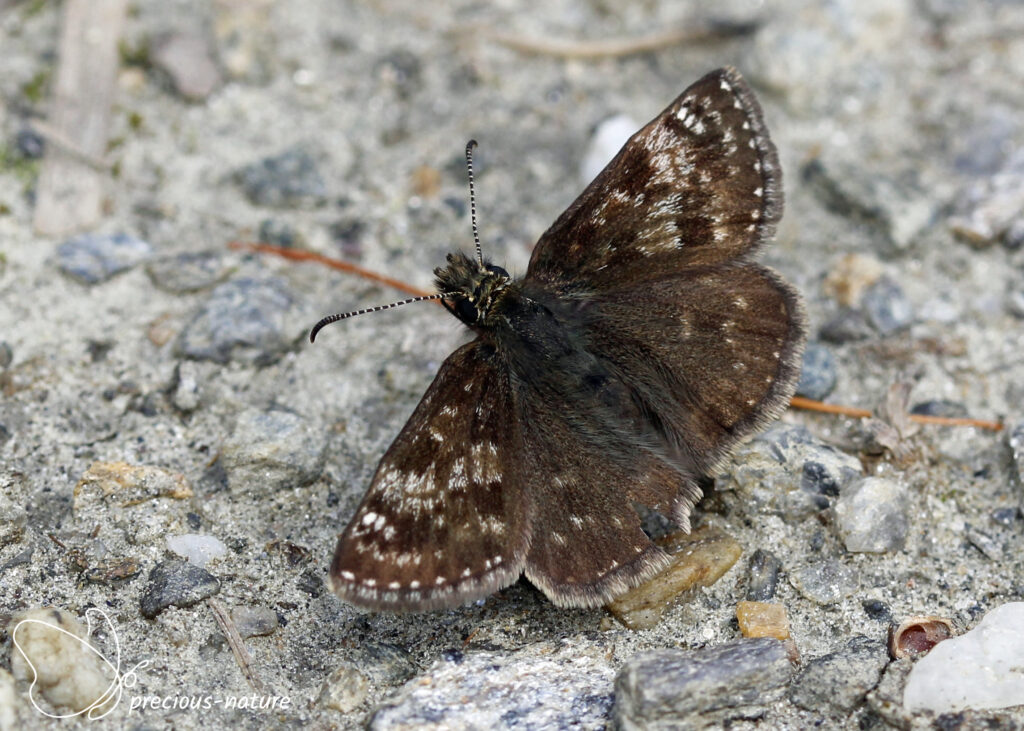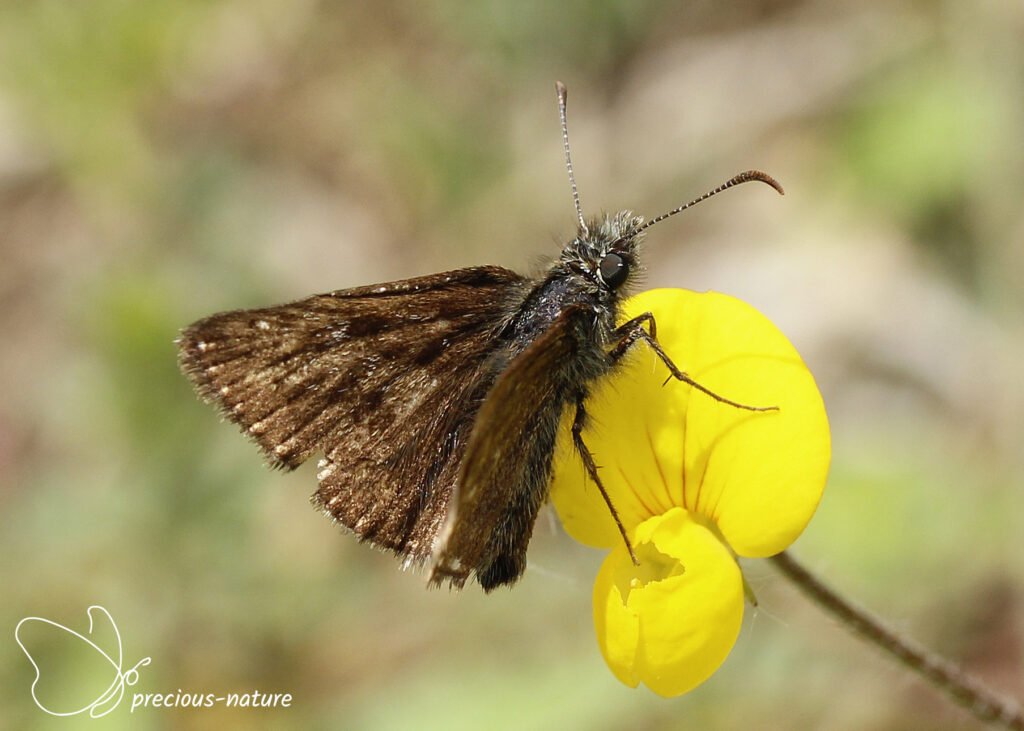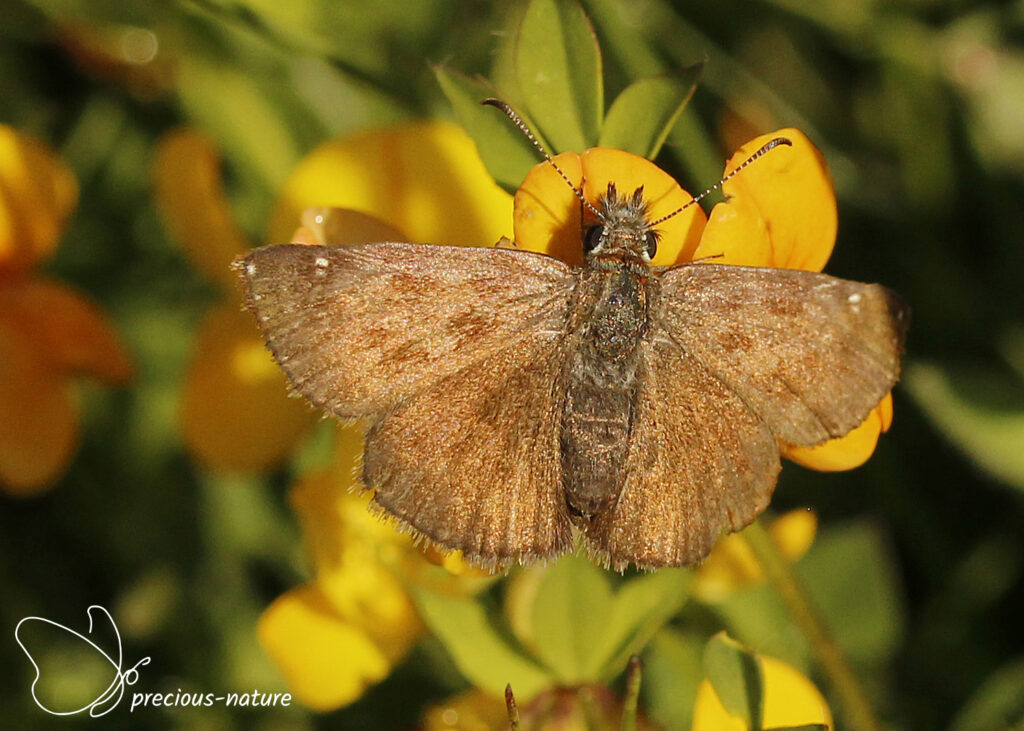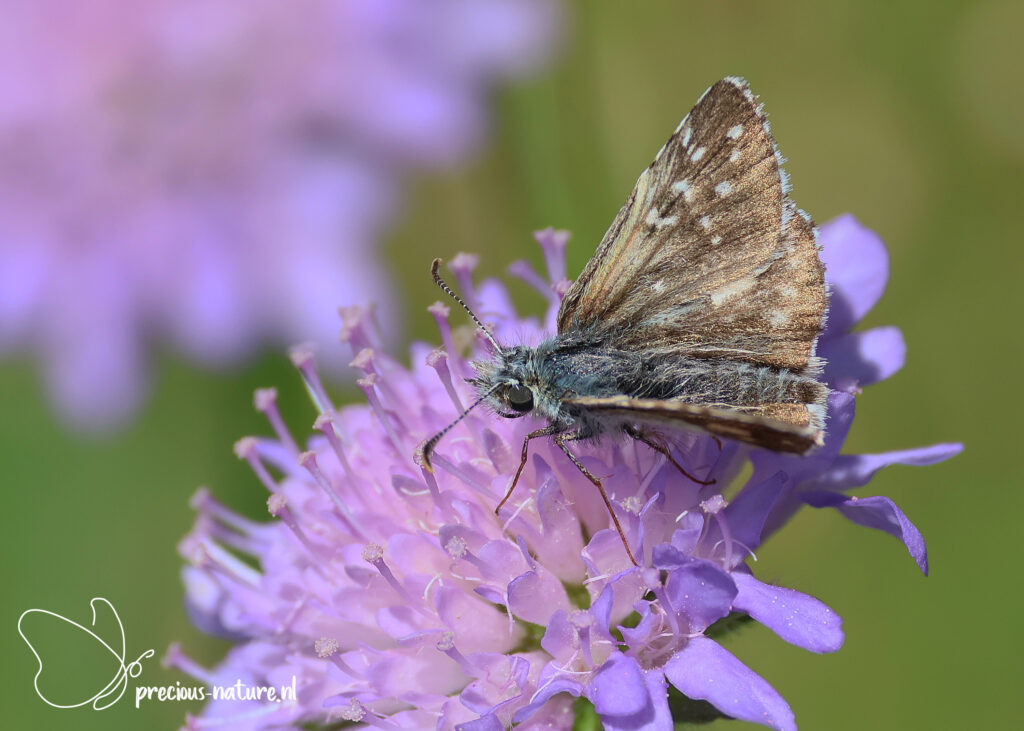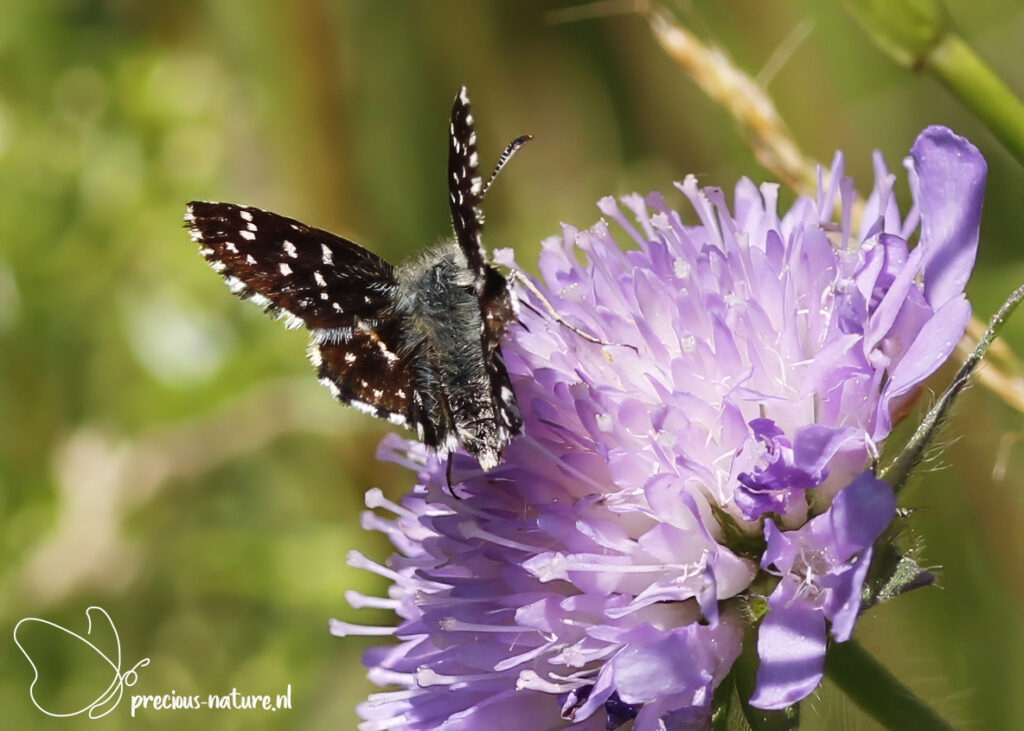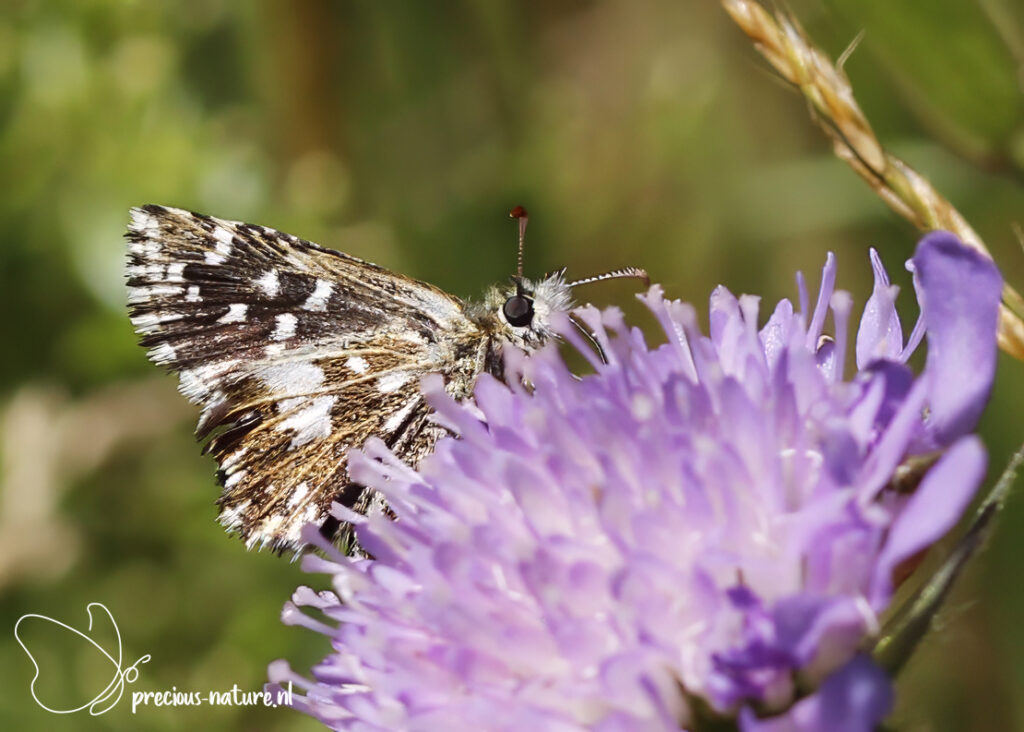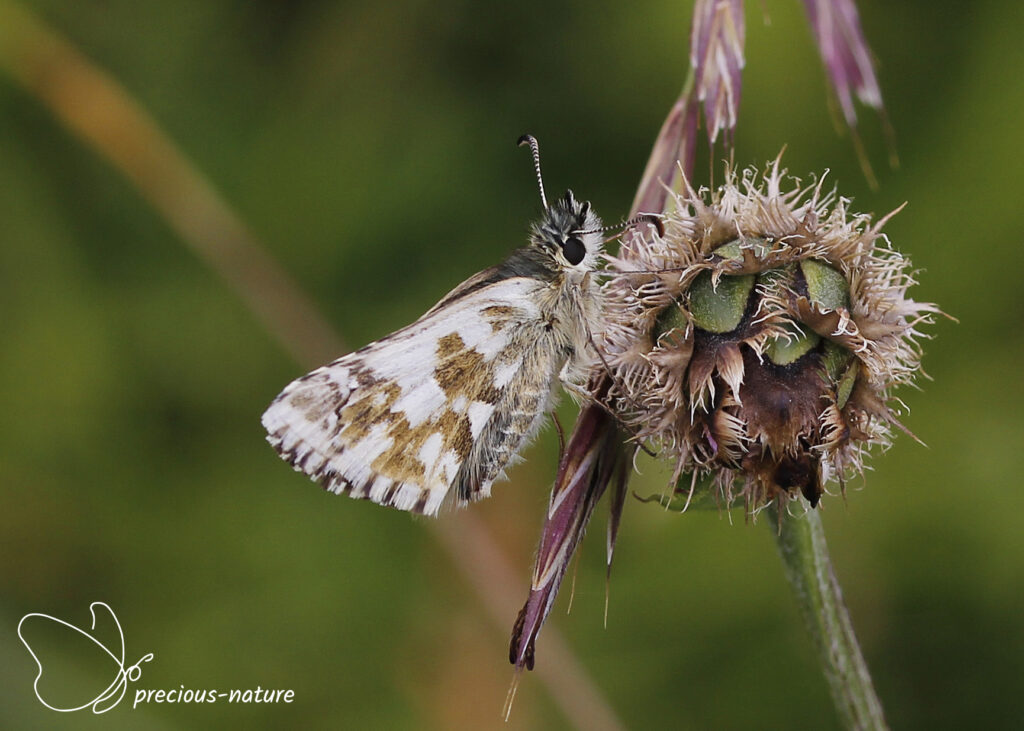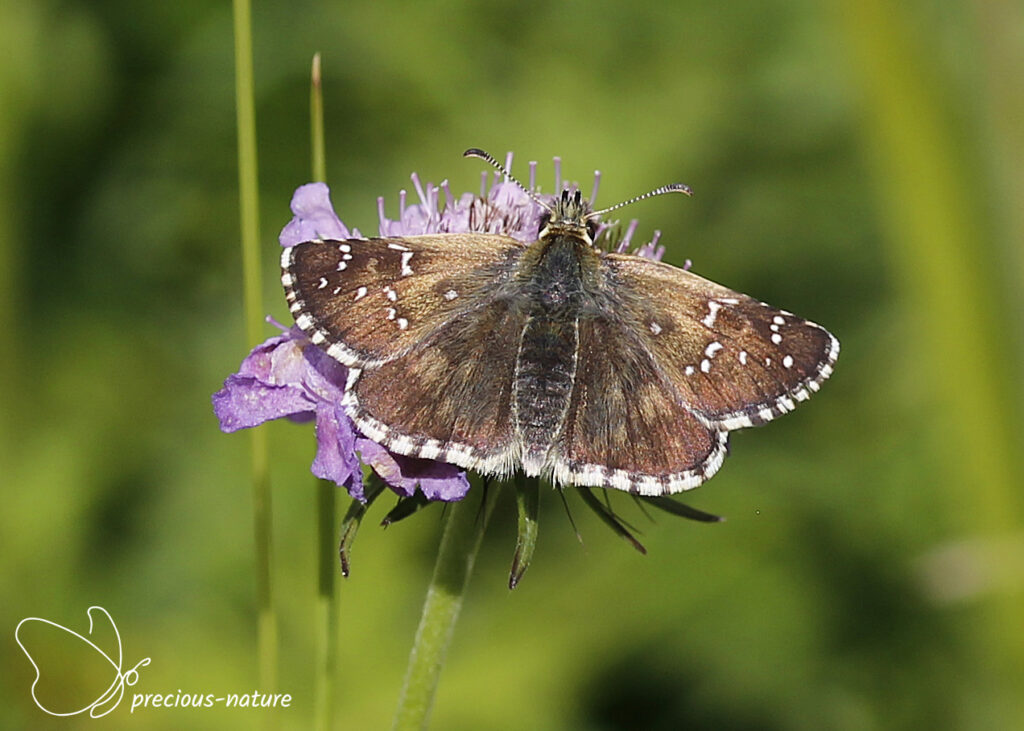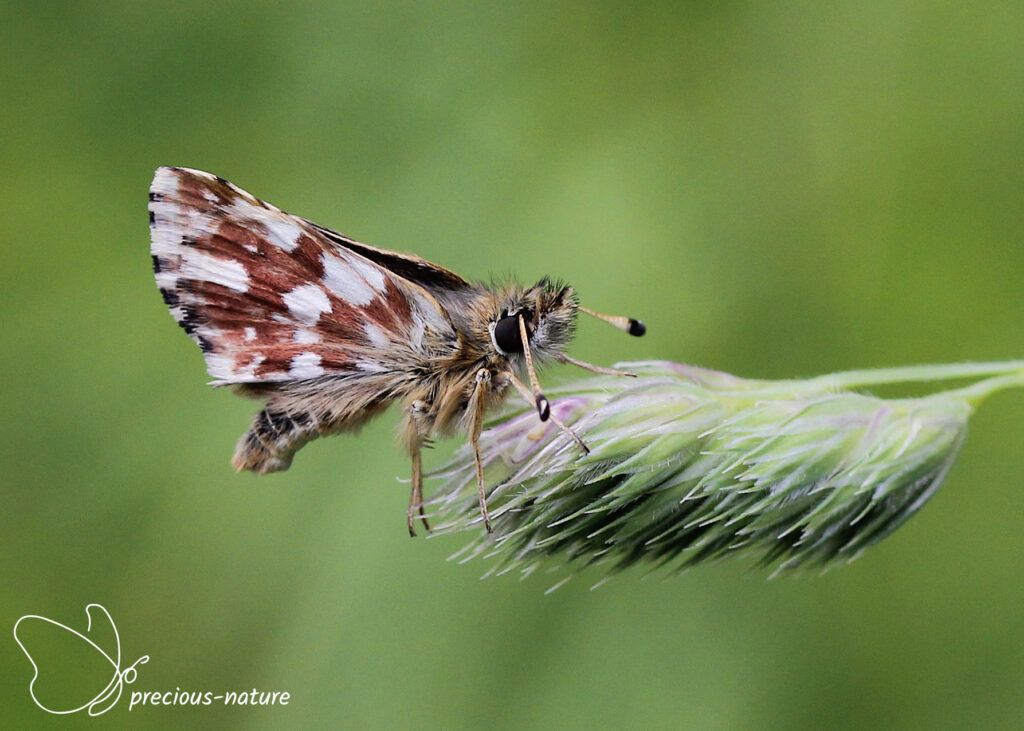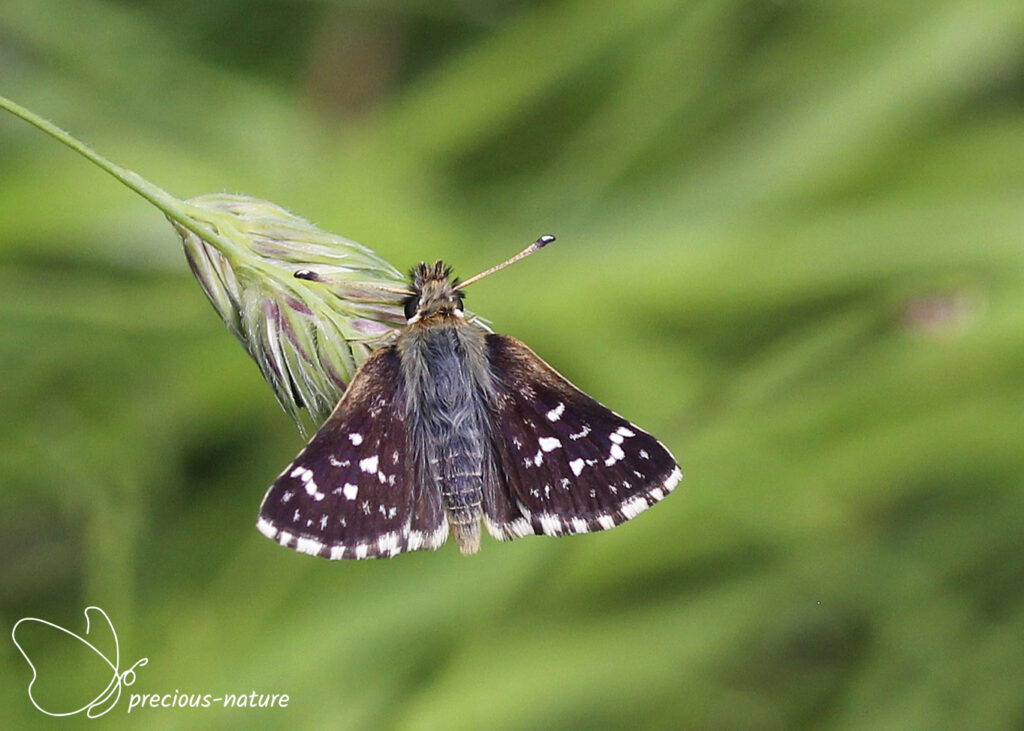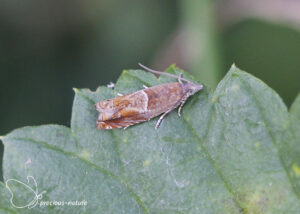The Skippers (Hesperiidae) are tiny butterflies, and their name refers to their rapid and darting flight. In some species, the adults rest with the forewings and hindwings in different planes, a characteristic never found in other families. They have several other characteristics that make them considered a more primitive group of butterflies related to some moth families. The well-known subfamilies are the Grass Skippers (Hesperiinae), Skipperlings (Heteropterinae), and the Spread-winged Skippers (Pyrginae). You can find the Long-tailed Skippers (Eudaminae) in the tropical region. Skippers have sturdy antennae with a relatively wide separation at their base, and the antennal club is hooked. They are also equipped with a strikingly long coiling tongue. Some species have “tails” on the hindwing.
Subfamily: Eudaminae
Tribe: Eudamini
Genus: Urbanus
Plain Longtail – 2017 (CO)
(NCBI-index: 355208)
The Plain Longtail (Urbanus simplicius) belongs to a tribe of the Eudaminae, the Eudamini (long tails). They occur in (sub)tropical areas and often along forest roads at altitudes of up to 1500 meters. I spotted this longtail in Bogotá (Colombia) on a mountain path used as a pilgrimage road to the church on Monserrate. The butterfly has spread its wings in its resting state, is entirely brown and has a striking “feathered” tail. Males have a coastal fold enclosing scent scales on the costa of the forewing. The inner band of the hindwing underside is connected to the brown spot near the costa. At the costa, there is sometimes a tiny, thin, cream-coloured stripe. The wingspan is 38-50 mm. Host plant: Herbs and grasses of the legume family. Dutch name: Gewone langstaart. Frisian name: Gewoane langsturt.
Subfamily: Eudaminae
Tribe: Eudamini
Genus: Urbanus
Long-tail Skipper – 2017 (CO)
(NCBI-index: 355207)
The Long-tail Skipper (Urbanus proteus) is a butterfly directly related to the Plain Longtail (Urbanus simplicius). This skipper occurs in the subtropical region of America. I spotted this butterfly in Medellín (Colombia). The Long-tail Skipper has cream-coloured spots on both the top and underside of the wing. Most noticeable is the blue-green colour on the top of the body. The difference with the Urbanus dorantes, which does not have a blue-green colour but looks more like the Long-tail Skipper, is the black continuous band at the underside of the hindwing. The wingspan is 45-60 mm. The antennas don’t have a knob on the end. You can see the slightly thickened curved hook very nicely. Host plant: Herbs of the legume family, Pea, Bean, Soy. Dutch name: Langstaartdikkopje. Frisian name: Langsturtgroukopke.
Subfamily: Hesperiinae
Tribe: Erionotini
Genus: Suastus
Palm Bob – 2022 (INA)
(NCBI-index: 218763)
The Palm Bob (Suastus gremius) is typical in Indonesia. Sightings are pretty common in nature reserves, urban parks, and gardens. During my trip to Bali, I saw this species for the first time in Beraban. The adults are fast fliers and are skittish when disturbed. They visit flowers, bask in sunny weather, and settle on bird droppings. The upper side of the wings is brown, and the forewing is decorated with light yellow spots at the cell end and spaces 1b, 2, 3, 6, 7, and 8. The upper side of the hind wing is unmarked. The torn cilia are whitish. The undersides of the wings are grey-brown, and the hindwing is covered with pale yellow scales and has several relatively large and well-defined black spots. The wingspan is 33-35 mm. Host plant: Palm Tree. Dutch name: Palmdikkopje. Frisian name: –
Subfamily: Hesperiinae
Tribe: Hesperiini
Genus: Hesperia
Silver-spotted Skipper – 2024 (CH)
(NCBI-index: 291688)
The underside of the hindwing of the Silver-spotted Skipper (Hesperia comma) is grey-green with some conspicuous white spots. The silver-white spots on the underside of the hindwing are particularly distinctive. The somewhat larger spot near the body (the ‘comma’ to which this species owes its Dutch name) is characteristic. The male of the Silver-spotted Skipper has a clear, thick scent stripe on the upperside of the forewing caused by specialised black scent scales. The flight period is one generation from late June to mid-September, and the wingspan is 29-34 mm. Host plant: Sheep’s Fescue, Rock-rose, Thyme. Dutch name: Kommavlinder. Frisian name: Kommaflinter.
Flying period:

Subfamily: Hesperiinae
Tribe: Hesperiini
Genus: Lerema
Clouded Skipper – 2017 (CO)
(NCBI-index: 691651)
A skipper that also has white spots on the wings like the Long-tail Skipper (Urbanus proteus) is the Clouded Skipper (Lerema accasius). However, the long tail is missing. The Clouded Skipper spotted in Medellin, Colombia, has dark brown wings, with the male having a dark black stripe on the top of the forewing and the female having transparent white spots. The underside of the hindwing has dark and light spots and a blue-green glow. The wingspan is 32-45 mm, and the flight period is all year round. Host plant: St. Augustine grass and Woolly Beard grass. Dutch name: Gevlekt dikkopje. Frisian name: –
Subfamily: Hesperiinae
Tribe: Hesperiini
Genus: Ochlodes
Large Skipper – 2016 (NL)
(NCBI-index: 876063)
The Large Skipper (Ochlodes sylvanus) is a butterfly that flies around in one generation from early June to September. The males are often found perching in a prominent, sunny position, awaiting passing females. The butterfly is easy to identify because the hooks on the tip of the antenna are distinctive and are not present on the Small and Essex Skipper. Males have a thick black scent line through the centre of the forewing. Undersides have faint orange spots. A faint chequered pattern on both sides of the wings distinguishes this species from the Small and Essex Skipper. The wingspan is 33-35 mm. Host plant: Cock’s-foot, False Brome, and Purple Moor-grass. Dutch name: Groot dikkopje. Frisian name: Foars groukopke.
Flying period:

Subfamily: Hesperiinae
Tribe: Hesperiini
Genus: Thymelicus
Small Skipper – 2008 (NL)
(NCBI-index: 272628)
The Small Skipper (Thymelicus sylvestris) is a butterfly that flies around in one generation from May to August. The butterfly is challenging to identify and often confused with the Essex Skipper (Thymelicus lineola). The tips of the antenna are orange (best viewed head-on), and the black edge of the wings is sharply marked. Males have a thin black line through the centre of the forewing. They have bright orange-brown wings held with the forewings angled above the hindwings. A closer examination reveals that many individuals are nectaring or basking with their wings held in a distinctive half-open posture, characteristic of skipper butterflies. The wingspan is 30 mm. Host plant: Meadow Foxtail, Timothy grass, False Brome, Cock’s-foot. Dutch name: Geelsprietdikkopje. Frisian name: Gielteistergroukopke.
Flying period:

Subfamily: Hesperiinae
Tribe: Hesperiini
Genus: Thymelicus
Essex Skipper – 2009 (NL)
(NCBI-index: 218773)
The Essex Skipper (Thymelicus lineola) is a butterfly that flies in one generation from late June to late August. The butterfly is relatively easy to identify, but attention should be paid to similar skippers. The tip of the antenna is black, and the black border on the wings can be seen running along the veins. The orange-brown wings are held with the forewings angled above the hindwings. Males have a thin black line through the centre of the forewing, but this scent brand is shorter for the Small Skipper (Thymelicus sylvestris) and doesn’t angle to the edge of the forewing. The wingspan is 27-30 mm. Host plant: Cock’s-foot, Timothy, Creeping Soft-grass. Dutch name: Zwartsprietdikkopje. Frisian name: Swartteistergroukopke.
Flying period:

Subfamily: Heteropterinae
Genus: Carterocephalus
Chequered Skipper – 2023 (BE)
(NCBI-index: 218720)
The Chequered Skipper (Carterocephalus palaemon) is a distinctive butterfly with many yellow markings. The top of the brown forewing contains many more prominent yellow spots separated by brown veins, while on the top of the hindwing, the spots are smaller and less prominent. The underside of the forewing is orange with brown spots. The underside of the hindwing is yellow with several larger, striking light yellow, black-rimmed spots, and along the trailing edge, some smaller, light yellow, black-rimmed spots are neatly lined up. The base of the antennal bud is dark underneath in the male and yellow in the female. The flight period is one generation, from mid-May to the end of June, and the wingspan is 29-31 mm. Host plant: Purple Moor-grass. Dutch name: Bont dikkopje. Frisian name: Bûnt groukopke.
Flying period:

Subfamily: Pyrginae
Genus: Erynnis
Dingy Skipper – 2024 (CH)
(NCBI-index: 520884)
There are three reasons why the Dingy Skipper (Erynnis tages) hardly occurs in the Netherlands anymore. Due to the enrichment of fertilisers, the vegetation in the habitat grows dense. In these habitats, mowing is too intensive, which means that caterpillars have no chance, and the habitats become too small for exchange with other populations. It flies very fast and shoots low over the grass and dry ground. It can be territorial, but the territories are small, and there are often neighbours, frequently resulting in fights. Despite its name, a newly hatched Dingy Skipper exhibits a subtle pattern of brown and grey that is quite beautiful. The row of white spots along the wing edges on the upper side of the fore and hind wings is unique. The underside of the wings is brown with several small white spots in the outer part of the wing. However, this butterfly lives up to its name because the scales are lost after a while, resulting in a dull brown appearance. The flight period spans one generation from May to mid-June, and occasionally a second generation from mid-July to mid-August. The wingspan is 27-34 mm. Host plant: Bird’s-foot-trefoil. Dutch name: Bruin dikkopje. Frisian name: Brún groukopke.
Flying period:

Subfamily: Pyrginae
Genus: Pyrgus
Oberthür’s Grizzled Skipper – 2023 (DE)
(NCBI-index: 876069)
In the Netherlands, you will not encounter the Oberthür’s Grizzled Skipper (Pyrgus armoricanus), but in Germany, this butterfly has expanded considerably in the last decade. A different route had to be chosen during a butterfly trip due to a road closure. In addition, a beautiful field with spicy crops was passed, where it was decided to see if any notable species were present. This resulted in this beautiful Oberthür’s Grizzled Skipper that can easily be confused with the Red-underwing Skipper (Spialia sertorius) and the Grizzled Skipper (Pyrgus malvae). The spots on the upper side of the forewing of Oberthür’s Grizzled Skipper are slightly contrasting and show a disordered pattern. There are no stains along the back edge. On the upper side of the hindwing, there are always two rows of diffuse, brownish-grey spots that are usually conspicuous. The underside of the hindwing is greenish or brownish. The white median band is almost complete and has a tiny and then a large, nearly round white spot near the inner edge of the wing. The Red-underwing Skipper and the Grizzled Skipper are usually slightly smaller. The Grizzled Skipper has a row of disordered, small grey spots along the trailing edge of the upper side of the forewing. The flight period typically spans two generations, from May to the end of August, and the wingspan measures 24-28 mm. Host plant: Silver or hoary cinquefoil. Dutch name: Bretons spikkeldikkopje. Frisian name: –
Flying period:

Subfamily: Pyrginae
Genus: Pyrgus
Grizzled Skipper – 2023 (DE)
(NCBI-index: 218760)
The upper side of the wings of the Grizzled Skipper (Pyrgus malvae) is dark brown with many sharply marked, white spots. There is a row of small, grey spots along the trailing edge of both the fore and hindwings. The most prominent feature is a sharp white square spot with a triangular incision on the upper side of the hindwing. The underside of the hindwing is yellow-green or red-brown, with the large white spots standing in a row but not forming a continuous band. The light discal spot in cells c2 and c3 is reduced or absent. The flight period spans one generation, from May to early July, and the wingspan ranges from 20 to 24 mm. Host plant: Agrimony and Creeping Cinquefoil. Dutch name: Aardbeivlinder. Frisian name: Ierdbeiflinter.
Flying period:

Subfamily: Pyrginae
Genus: Pyrgus
Large Grizzled Skipper – 2024 (CH)
(NCBI-index: 876067)
The spots on the upperside of the dark brown forewing of the Large Grizzled Skipper (Pyrgus alveus) are generally small, and the markings on the upperside of the hindwing are rather diffuse and indistinct. The disc-shaped area on the underside of the olive-green grey hindwing has a roughly rectangular white block. The wings are bordered with a black and white checkered fringe. The flight period spans one generation, from late June to mid-August, depending on the location and altitude. The wingspan is 25-30 mm. Host plant: Barren Strawberry, Common Rockrose. Dutch name: Groot spikkeldikkopje. Frisian name: –
Flying period:

Subfamily: Pyrginae
Genus: Spialia
Red Underwing Skipper – 2024 (CH)
(NCBI-index: 509483)
The upperside of the forewing and hindwing of the Red Underwing Skipper (Spialia sertorius) is brown with a row of clearly marked white spots in the inner margin. It can be distinguished from the Grizzled Skipper (Pyrgus malvae) based on the white border spots. These are in a regular row in the Red Underwing Skipper, while in the Grizzled Skipper, two white spots are directed outwards. Another characteristic difference is the colour of the underside of the hindwing. In the Red Underwing Skipper, this is reddish brown with angular white spots, while in the Grizzled Skipper, it is usually green with white spots. The Red Underwing Skipper can be distinguished from the Orbed Red Underwing Skipper (Spialia orbifer) by the angular white spots on the reddish-brown underside of the hindwings. The underside is yellowish in the Orbed Red Underwing Skipper with rounded white spots. The flight period spans one generation, from April to August, and the wingspan ranges from 22 to 26 mm. Host plant: Small Pimpernel. Dutch name: Kalkgraslanddikkopje. Frisian name: –
Flying period:


